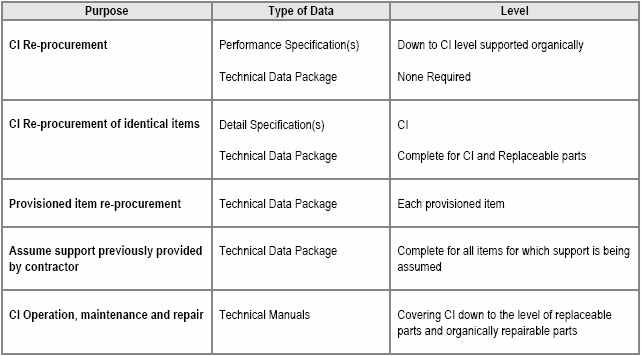MIL-HDBK-61A: Configuration Identification
< Previous | Contents | Next >
5.7 Engineering Release
Engineering release is an action that makes configuration documentation available for its intended use and subject to the contractor's configuration control procedures.
Configuration documentation that requires Government approval is subject to Government configuration control. The contractor's engineering release process must prevent all engineering releases related to a class I change to a Government approved document from being released until the Government has approved the class I change. [Details: Section 6]
Acquisition program managers should ensure that both contractors and Government activities follow engineering release procedures which record the release and retain records of approved configuration documentation (engineering release records). These records provide:
-
An audit trail of CI documentation status and history
-
Verification that engineering documentation has been changed to reflect the incorporation of approved changes and to satisfy the requirements for traceability of deviations and engineering changes
-
A means to reconcile engineering and manufacturing data to assure that engineering changes have been accomplished and incorporated into deliverable units of the CIs.
[Details: Activity Guide: Table 5-12. Engineering Release Record Content and Functional Capability]
It is probable during development that contractors would release several, progressively more detailed versions of specifications and drawings to their various functional areas or integrated product teams or to the Government (for technical reviews, progress reports). Configuration documents that require formal submittal to the Government for approval [Refer to Section 9] may be at an advanced revision level (Revision "G," for example) at the time of initial submittal. Under no circumstances is it prudent for the Government to ask a contractor to make his initial submittal of a document the "no-change" or initial revision, when it is not. By doing so, traceability to information that may become important at some future time could be lost. An additional liability is that the Government could incur a significant cost to have the drawings redrawn at the "no-change" revision, and the resulting documents would duplicate the identifiers of documents already in existence.
Detail design documents under the contractor control must be kept current with all changes/modifications and releases including changes occurring as a result of test activity. The record of prior release and use history of configuration documentation represents the developmental history of the CI and may be needed to support cost tradeoffs and the rationale for changes to design constraints. Release records should indicate superseded as well as superseding requirements at least until superseded configurations no longer exist. Superseded requirements then may be retained as historical information.
All approved Class I and II engineering changes released for production are identified by change identifiers. The change is documented and released prior to formal acceptance of the deliverable unit in which the engineering change is first installed. The contractor's release process should verify the approval/concurrence status of each Class I/Class II change prior to the release of the related documentation for use in the generation of deliverable units. The release process and released documentation should identify engineering changes, and retain a record of superseded configuration requirements which are/were incorporated into delivered CIs.
Each approved Class I engineering change is incorporated into all units, or into complete blocks of units, within one mission, design, series or type, model, series of the CIs affected. Verification of the production incorporation of authorized engineering changes is accomplished for all CIs. Documentation of the actual released configuration for each CI at the time of its formal acceptance is retained in release records. This information is of particular importance, especially if there are warranties associated with the CI or its components.
Methods to ensure acceptable contractor engineering release systems include prior knowledge, through past performance, of the contractor's existing procedures, prior certification of the contractor's procedures; and a contractor's configuration management plan delineating his procedures.
During the operational support period, the Government will need design disclosure information on all CIs down to the level that will be supported by the Government. In addition, the Government may need additional design details prior to or at the end of Production, depending upon a number of factors such as:
-
The need for continued support of operational items
-
The type of specification to be used for re-procurement if re-procurement is anticipated. [Details: Activity Guide: Table 5-13. Government Acquisition of Detailed Design Data].
In a CALS integrated data environment, selected information in a contractor's release record may be shared by the Government or downloaded to a CM AIS. The actual documents also may be downloaded (as raster images) to the JEDMICS data depository. Until the transition to these standard systems is completed, a variety of methods are being employed to populate the databases being used by the various services. There is currently no standard engineering release system used by all Government activities.
Table 5-12 is intended to be used to evaluate a contractor's engineering release system from both a data content and a functional capability point of view. Acquisition reform has affected the degree of detailed design and engineering release information that the Government needs to perform its mission. Table 5-15 addresses the various levels of detailed design data Government needs to acquire in a variety of circumstances.
Activity Guide: Table 5-12. Engineering Release Record Data Content And Functional Capability


Activity Guide: Table 5-13. Government Acquisition of Detailed Design Data

For correct application of this information, see NOTE on Contents page